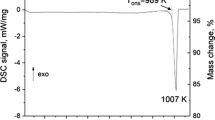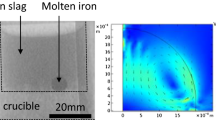Abstract
The coreduction of iron and zinc from the B2O3–CaO–FeO–ZnO oxide melt by carbon monoxide or hydrogen is described by means of thermodynamic simulation in approximation to real processes; it provides batch addition of a reducing gas and removal of a metallic phase and waste gases. The calculations are carried out with allowance for the disproportionation of FeO into Fe and Fe3O4. For a mass ratio FeO/ZnO = 10, the disproportionation of FeO ensures the transition of 1.3–1.5 wt % Zn into gas. Upon addition of hydrogen or carbon monoxide to the system, the oxide melt composition is modified: the fractions of iron and zinc oxides decrease, but the degree of their metallization (φFe, φZn) increases. Complete (>99%) transition of zinc into a gas phase at 1773 K and 1673 K is detected upon addition of hydrogen in an amount of 36 and 65 dm3/kg, respectively, or of carbon monoxide in an amount of 58 and 80 dm3/kg, respectively. When hydrogen is used, the degree of iron metallization reaches 24.0–15.8% in the temperature range 1337–1573 K against 11.0–6.0% for carbon monoxide. The temperature increment in the considered VCO and \({{V}_{{{{{\text{H}}}_{2}}}}}\) flow rate ranges decreases the degree of metallization φFe. The obtained data can be used to adjust the conditions of treatment of oxide (slag) melts and to achieve the required degrees of metallization of zinc and iron.



Similar content being viewed by others
REFERENCES
A. L. Kotel’nikova and V. F. Ryabinin, “Features of material composition and possibilities of utilization of wastes of secondary processing of copper smelting slags,” Litosfera 18 (1), 133–139 (2018).
I. E. Doronin and A. G. Svyazhin, “Dust and sludge of steel smelting aggregates as a raw stuff for production of zinc and steel,” Izv. Vyssh. Uchebn. Zaved., Tsvetn. Metall., No. 5, 31–35 (2012).
L. I. Leontyev and V. G. Dyubanov, “Technogenic wastes of ferrous and non-ferrous metallurgy and environmental issues,” Ekol. Prom. Ross., No. 4, 32–35 (2011).
R. G. Reddy, V. L. Prabhu, and D. Mantha, “Zinc fuming from lead blast furnace slag,” High Temp. Mater. Proc. 21 (6), 377–386 (2002).
K. Verscheure, M. Camp, B. Blanpain, P. Wollants, P.C. Hayes, and E. Jak, “Zinc fuming processes for treatment of zinc containing residues,” in Proceedings of Lead & Zinc’05 Symposium (MMIJ, Osaka, 2005), pp. 943–960.
S. Hughes, M. A. Reuter, R. Baxter, and A. Kaye, “Ausmelt technology for lead and zinc processing,” in Lead and Zinc (Southern African Institute of Mining and Metallurgy, 2008), pp. 147–162.
D. Radovanovic, Z. Kamberovic, Z. Andjic, M. Ranitovic, and B. Markovic, “The effect of CaO and MgO addition and cooling rate on stability of slag obtained after jarosite and neutral leaching residue treatment in the Waelz process,” Physicochem. Probl. Miner. Proc. 54 (2), 484–495 (2018).
Xiaolong Lin, Zhiwei Peng, and Jiaxing Yan, et al., “Pyrometallurgical recycling of electric arc furnace dust,” J. Clean. Product. 149, 1079–1100 (2017).
V. V. Kozyrev, A. D. Besser, and B. M. Paretskii, “On zinc extraction from lead smelting slags,” Elektrometallurgiya, No. 6, 31–35 (2013).
S. N. Tyushnyakov and E. N. Selivanov, “Electrothermal technology of utilization of zinc containing slags of copper smelting and dust of blast furnace and steel smelting industries,” Metallurg, No. 3, 37–45 (2020).
G. G. Richards, D. Dreisinger, A. Peters, and J. K. Brimacombe, “Mathematical modeling of zinc processes,” in Proceedings of International Symposium on Computer Software in Chemical and Extractive Metallurgy (Metallurgical Society of the Canadian Institute of Mining and Metallurgy, 1988), pp. 223–252.
H. Y. Sohn, “Process modeling in non-ferrous metallurgy,” in Treatise on Process Metallurgy: Industrial Processes, Ed. by S. Seetharaman (Elsevier, Oxford 2014), Chapter 2.4, pp. 701–838.
G. G. Mikhailov, B. I. Leonovich, and Yu. S. Kuznetsov, Thermodynamics of Metallurgical Processes and Systems (MISiS, Moscow, 2009).
V. Boronenkov, M. Zinigrad, L. Leontiev, E. Pastukhov, M. Shalimov, and S. Shanchurov, Phase Interaction in the Metal–Oxide Melts–Gas System. The Modeling of Structure, Properties and Processes (Springer Berlin, Heidelberg, 2012).
S. N. Tyushnyakov and E. N. Selivanov, “Thermodynamic simulation of zinc reduction from copper smelting slag,” Butlerov Soobshch. 43 (9), 108–115 (2015).
A. S. Vusikhis, L. I. Leontyev, D. Z. Kudinov, and E. N. Selivanov, “Thermodynamic simulation of zinc and iron reduction from multicomponent silicate melt in the course of bubbling. Report 1. Reducing agent: CO–CO mixture,” Izv. Vyssh. Uchebn. Zaved., Chern. Metall. 61 (9), 731–736 (2018).
A. S. Vusikhis, L. I. Leontyev, E. N. Selivanov, and V. P. Chentsov, “Simulation of gas reduction of metals from multicomponent oxide melt in bubble layer,” Butlerov Soobshc. 55 (7), 58–63 (2018).
Phase Diagrams of Binary and Multicomponent Systems on the Basis of Iron, Ed. by O. A. Bannykh, P. B. Budberg, S. P. Alisova, et al., (Metallurgiya, Moscow, 1986).
A. S. Vusikhis, E. N. Selivanov, L. I. Leontyev, V. P. Chentsov, and S. N. Tyushnyakov, “Zinc reduction modeling from B2O3–CaO–FeO–ZnO melts by carbon monoxide,” in Proceedings of the 19th Israeli–Russian Binational Workshop on the Optimization of Composition, Structure and Properties of Metals, Oxides, Composites, Nano- and Amorphous Materials (Yekaterinburg, 2020), pp. 221–227.
Funding
This work was supported by the Russian Foundation for Basic Research, project no. 18-29-24093mk.
Author information
Authors and Affiliations
Corresponding author
Ethics declarations
The authors declare that they have no conflicts of interest.
Additional information
Translated by I. Moshkin
Rights and permissions
About this article
Cite this article
Vusikhis, A.S., Selivanov, E.N., Leontyev, L.I. et al. Thermodynamic Simulation of Metal Reduction from B2O3–CaO–FeO–ZnO Melts by Hydrogen and Carbon Monoxide. Russ. Metall. 2022, 475–480 (2022). https://doi.org/10.1134/S0036029522050111
Received:
Revised:
Accepted:
Published:
Issue Date:
DOI: https://doi.org/10.1134/S0036029522050111




